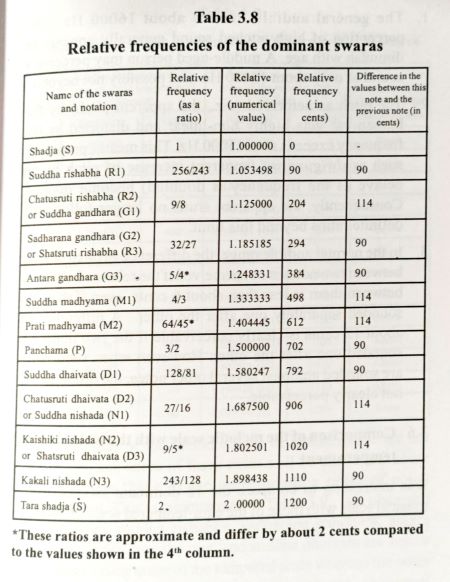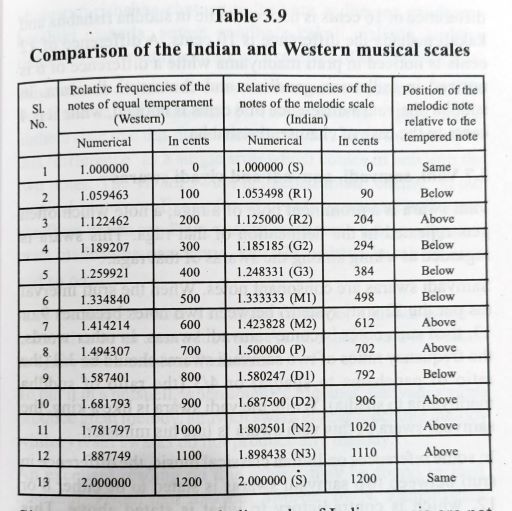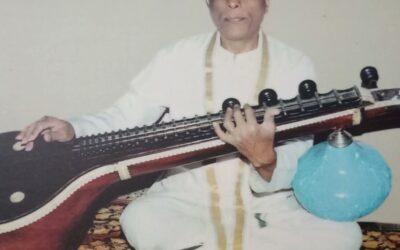Chapter 3 (Contd.)
SRUTIS AND THEIR FUNDAMENTAL PROPERTIES
3.5 Experimental observations.
As experiment was conducted to observe how these 22 srutis actually sound. All of them may be generated and heard on a normal computer using the QBASIC (Quick Basic) program and using the SOUND command. This method of generating the microtones is perhaps the easiest and the best available today. The SOUND command is used as:
SOUND A, B
where A is the actual frequency in cycles per second (Hz.) and B the time duration.
Keeping the adhara shadja at 512 Hz., all the 22 srutis as derived here were generated using the SOUND command and then heard. Most of the dominant srutis, viz., suddha and chatusruti rishabhas, sadharana gandhara, suddha madhyama, panchama, suddha and chatusruti dhaivatas, and kakali nishada were heard perfectly when the relative frequencies shown in Table 3.2 were employed. Only two of the notes in Table 3.2 needed a slight correction by a pramana sruti. The swaras which needed corrections are:
1 Antara gandhara which needed to be lowered from 81/64 to 80/64 (=5/4).
2 Kaishiki nishada which needed to be increased from 16/9 to 9/5.
With this, the correct relative frequencies of the 12 swaras as we use them today are derived and these are shown in Table 3.8. However, the changed values of these swaras are inconsistent with the srutibheda sutras. This contradiction is resolved when we realise that the srutibheda sutras are more qualitative in nature and as such cannot be expected to be analytically exact. That the srutibheda process is not analytically exact is a well-known fact. (See for example, paragraph 2, page 70, ibid.) Nevertheless, it is remarkable that the srutibheda sutras still generate the frequency values that belong to the set of fourths and fifths. It may be noted that while many books list the 22 srutis, none (including those of Sambamurthy) give the correct choices of frequencies for the 12 dominant swaras employed in present day music. There is considerable mix-up of names, leaving the reader totally bewildered.
 The experiment also reveals that the non-dominant notes, (viz., the other 11 srutis, such as trisruti rishaba, etc.,) are heard slightly flatter or sharper (as the case may be) compared to the dominant notes and sound reasonably good. Even the displaced panchama (relative frequency of 678 cents) sounds reasonable. However, a certain amount of dissonance is noticed when these non-dominant notes are played together. The interval of a pramana sruti (24 cents) is clearly perceivable when the two srutis differing by this interval are sounded together. However, when they are sounded amongst other swaras, the difference is not easily perceivable. In this case, only a trained ear can notice the difference.
The experiment also reveals that the non-dominant notes, (viz., the other 11 srutis, such as trisruti rishaba, etc.,) are heard slightly flatter or sharper (as the case may be) compared to the dominant notes and sound reasonably good. Even the displaced panchama (relative frequency of 678 cents) sounds reasonable. However, a certain amount of dissonance is noticed when these non-dominant notes are played together. The interval of a pramana sruti (24 cents) is clearly perceivable when the two srutis differing by this interval are sounded together. However, when they are sounded amongst other swaras, the difference is not easily perceivable. In this case, only a trained ear can notice the difference.
The SOUND command is extremely useful not only in analyzing the micro tones but also useful in understanding the effect of frequency in general. Certain simple experiments were performed using the SOUND command and some of the general observations are listed:
1.The general audible limit is about 16000 Hz. The perception of high-pitched sound generally appears to diminish with age. A middle-aged person may perceive a sound of only about 12000 Hz.and possibly not beyond.
2.The pitch as perceived (viz., the apparent pitch) by the human ear gets highly non-linear and distorted as the frequency exceeds about 5000 Hz. This means, properties such as dwigunatwa (apparent increase of pitch by an octave as the frequency is doubled) become invalid. Consequently, the apparent srutis no longer follow any definite ratios beyond this limit.
- In the normal audible range, the difference in pitch, or sruti between two notes is not perceived if the relative frequency between them is less than about 6 cents, even if they are sounded separately one after the other. A difference of about 12 cents is clearly perceivable if the two notes are sounded one after the other. However, when such notes are sounded amongst several other notes, the difference is not clearly perceivable.
3.6 Comparison of the melodic scale with the scale of equal temperament
It is interesting to compare the 12 dominant swaras of our musical scale with tho0se of the equi-tempered scale of Western music.
Since the notes of the melodic scale of Indian music are not equally spaced, some of these notes will be above and some will be below those of the corresponding notes of equal temperament. This is summarized in Table 3.9. It is observed that the notes suddha rishabha, sadharana gandhara, antara gandhara, suddha madhyama, and suddha dhaivata are below the corresponding notes of the tempered scale whereas the notes chatusruti rishabha, prati madhyama, panchama, chatusruti dhaivata, kaishiki nishada and kakali nishada are above the corresponding notes of the tempered scale. The largest difference of 20 cents is noticed in the case of kaishiki nishada and the smallest deviation of 2 cents is noticed in anchama and suddha madhyama. In the case of antara gandhara, a difference of 16 cents is noticed while in suddha rishabha and kakali nishada the difference is 10 cents. A difference of 12 cents is noticed in prati madhyama while a difference of 6 is noticed in sadharana gandhara and chatusruti dhaivata. In suddha dhaivata a difference of 8 cents is noticed, while it is 4 cents in the case of chatusruti rishabha.

3.7 Vadi, samvadi, anuvadi and vivadi swaras
Vadi swara is a prominent note of a raga: a note which often gets repeated in the delineation of that rage. This swara is regarded as a king among the swaras of that raga.
Samvadi swaras are consonant notes. When the sruti interval (as per the 22 sruti system) between two notes becomes 9 or 13, then such notes become samvadi swaras. In other words, the frequency ratios of two samvadi swaras should be 3/2 ( the ratio of panchama to shadja) or 4/3 (the ratio of suddha madhyama to shadja). While the vadi swara is like a king, the samvadi swara of this vadi swara is like his minister.
In some references on Indian classical music, the difference in sruti between two samvadi swaras is stated to be either 8 or 12, which is contradictory to what is stated above. This contradiction can be resolved if we realise that the interpretation of the term ‘difference in sruti interval’ is done differently by different authors. Consider for example, the interval between the swaras shadja and suddha madhyama. From Table 3.6 we find that the serial number of shadja is 0 and that of suddha madhyama 9. The difference between these two numbers is 9 and this is one interpretation. But some authors interpreted the number of srutis between these two (which is 8) as the sruti interval. Hence, care must be taken while interpreting different references.
The following pairs of notes such as shadja-panchama, shadja-suddha madhyama, suddha rishabha-suddha dhaivata chatusruti rishabha-chatusruti dhaivata, sadharana gandhara kaishiki nishada, antara gandhara-kakali nishada, suddha rishabha-prati madhyama are all examples of samvadi swaras.
When the sruti interval between two notes becomes 2, such notes are called dissonant or vivadi swaras. Again, some authors state that this difference should be 1 since they interpret this ‘difference’ as a single sruti which comes in between the two notes. The vivadi swara is likened to an ‘enemy’ in our musical literature. Examples of vivadi swaras are sadharana gandhara – antara gandhara, suddha madhyama-prati madhyama, prati madhyama-panchama, kaishiki nishada-kakali nishada and so on.
A swara that is neither a samvadi swara nor a vivadi swara is referred to as an anuvadi swara. An anuvadi swara is likened to a servant in musical literature.
To put it in a nutshell, when sounded together, samvadi swaras produce great melody, anuvadi swara give appreciable melody while, vivadi swaras do not produce any melody.
An excellent reading on this subject may be found in Vadi. Samvadi, Vivadi and Anuvadi Swaras by N. Ramanathan, pages 60-82, Vol.LIV, The Journal of Music Academy, Madras, 1983.
– to be continued…..
*****



